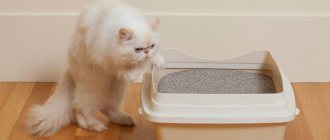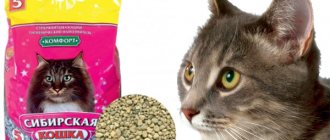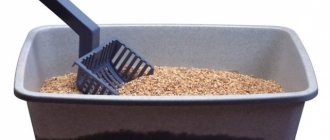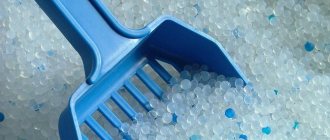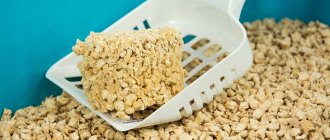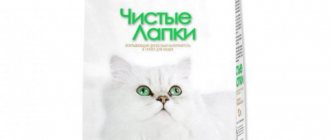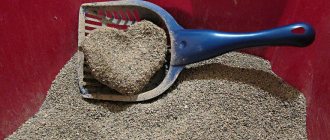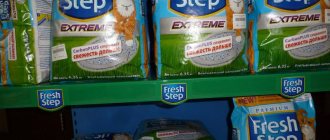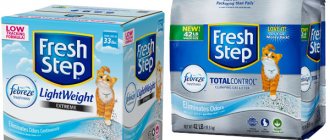Today, pet stores, supermarkets and veterinary pharmacies have a wide range of cat litters - from wood to silica gel. At first glance, it may seem that the costs of the material are insignificant, but still they are constant and noticeable for any average pocket. And if there is an opportunity to save, then why not take advantage of it? And you can do this with the help of the following five unexpected, but very good fillers.
Regular sawdust from a sawmill
You can replace purchased fillers with regular sawdust. They are 100% natural, which means they will not cause any harm to the health of your beloved pet.
In addition, sawdust absorbs moisture well. After absorbing liquid, they do not crumble, which means that the area around the pot will be clean and tidy.
If we talk about cost, then you can get sawdust completely free of charge or for a penny per bag. For example, at a nearby sawmill.
See also:
7 cheap cat litters that are better than expensive ones
We accustom the cat to the litter
Previously, we made a brief overview of the types of fillers. But in order for a cat to start using the toilet, you need to accustom it to it. Sometimes the absorbent itself plays a big role. Some cats do not accept silica gel fillers, while others always use them. If the cat does not approach the tray with the new litter, try to show him with raking movements that this product can be used for his needs.
When you accustom a kitten to the litter, results can be achieved faster. In order for the baby to understand where to go to the toilet, it is enough to take him to the tray after feeding. In small furry pets, the body is designed in such a way that after eating there is a natural desire to urinate.
If you want to accustom an adult cat to a new litter, you will have to spend a little more time. Your pet can be picky, and you shouldn’t scold her for that. The fact is that the lumps of filler can be either too large or small. Also, sometimes a cat's sensitive pads perceive them as too sharp. It happens that the whims of an animal are associated with odor, which can arise not only from the components of the filler. Typically, when the litter box is in the bathroom, where other scents are present, the cat's scent receptors may be irritated.
In order for your pet to start using the tray with the new filler, create comfortable conditions. The toilet can be located in the restroom, on the balcony or in the corridor.
forest sand
An equally budget-friendly solution is to use river sand as a filler. Especially if the pond is located close to home.
There is no need to talk about what “aromas” spread throughout the apartment after the cat “resolves all its issues.” So, river sand, although partially, still copes with the problem of unpleasant odor.
When choosing such a filler, you just need to take into account the fact that your pet can carry sand around the house. But here, as they say, you need to set your priorities correctly - clean more often and at the same time save or overpay for purchased litter.
How to Put Litter in a Mesh Litter Box for Cats
Inexperienced owners do not know how much to use toilet detergent. Fill the container with sand almost halfway, and press the grate on top. It is not right.
Any selected filler is poured into the tray so that it does not clog the grate placed on top. For small granules and particles, the reference point is the height of the legs of the removable mesh.
Larger ones won’t fit into the grate hole, but you shouldn’t pour too much. The cat will simply be uncomfortable on an unstable surface when the granules swell.
Some manufacturers, in order to additionally protect the room from stench, add a fragrance (the aroma of tea tree, fresh pine needles). If suddenly the cat goes to “relieve itself” in another place, the reason may be the lingering smell of feces.
Cat litter fresheners are also sold separately. Filler is poured into the tray and odorant granules are added to it (approximately 20 g per standard tray).
A separate area of additives for bulk cat litter is bioseptic. The cat may not like the smell of the air freshener and may cause allergies. In the same product, after opening the package, the slight smell quickly disappears. Bacteria, harmless to humans and animals, convert the enzyme urease into water and carbon dioxide. This guarantees the absence of the unpleasant “amber” of cat urine.
A cat is a clean animal. It won't fit in a dirty tray. If you don’t wash the grate in time, it will mark itself somewhere else.
When the owner is away for a long time, a little filler (not wood or paper) can be poured onto the mesh. The pet will dig up a “heap”, and the formed lumps, thanks to the sorbent, will prevent the smell from spreading.
Pellets for heating
Biofuel, which is obtained from wood waste and agricultural waste. They can not only heat the room, but also be used as cat litter. Compressed sawdust pellets are a natural, environmentally friendly material that copes well with unpleasant odors, does not stick to the animal’s paws and absorbs moisture well.
Pellets are also very easy to dispose of after use - they can be burned or simply collected in a bag and thrown into the trash.
By the way, buying pellets for cat litter is much cheaper than buying wood fillers from stores, and the effect of use is the same. Not to mention, if the house has a stove and the pellets are used for their intended purpose, the benefit is double.
See also:
Cat food with pesticides and antibiotics - 6 most popular brands
Dry grass, hay
Even in the city it is not difficult to make such a filler. In the low corners of each park there is thick grass - you need to collect it, choosing something that is soft to the touch, without hard and brittle stems. Dry the herb in the shade by spreading it in a thin layer on a flat surface covered with newspaper or cloth. When everything is completely dry, collect in a fabric bag and store in a dry, ventilated place. Animals love this type of litter. If it is not possible to collect grass with your own hands, it is worth purchasing hay - in pet stores it is sold as food for rodents.
Papers
If it is not always possible to get sand or sawdust, then there should be no problems with waste paper. Surely every home has unnecessary magazines and newspapers. It is from them that you can make a filler.
To do this, you need to cut the paper into pieces, or better yet, into strips and crumple them. Well, it would be simply ideal if the paper were passed through a shredder-shredder, which is found in every large office. The main thing is not to be lazy and change the tray as often as possible.
Newspapers
Newspapers torn into small pieces are an old “folk” way of arranging a cat’s litter box, very popular, but at the same time quite troublesome. To make it convenient for your cat to use the tray, you need to tear the paper quite finely, but it gets wet very quickly. You have to change the paper in the tray every day, or at most every other day, and it doesn’t cope with the smell very well.
You can buy a tray with a grid - then the moisture will flow down and the newspapers will get wet more slowly. To avoid odor, such a tray should be emptied several times a day.
Fine Slag - sold in bags in construction stores
The rating of the best substitutes for cat litter is completed by fine slag. This filler is capable of retaining unpleasant odors for some time and absorbs moisture well.
One of the disadvantages is that the animal can take it outside the tray.
But, if we talk about price, fine slag is much more profitable than special filler. It can be bought at any hardware store. A bag of slag will probably last longer than 5 kg of special material, but it will cost several times less.
Of course, when choosing litter, you should also take into account the preference of the animal itself. Not everything suits everyone. But still worth a try.
How to choose a cat litter
When choosing the type of cat litter, you need to rely on the following criteria:
- The optimal price for you. In order for the smell to be retained in the filler granules, they need to be sprinkled in a layer of at least 3 cm and removed in a timely manner. There is no point in buying an expensive filler and then saving money by rarely changing it.
- Your personal preferences. Cleaning the tray is up to you, so you have the right to choose: clumping or absorbent, more aesthetically pleasing silica gel or easy-to-clean wood.
- Animal preferences. Some cats care about a clean and dry litter box, some don't. Some like to rustle and bury themselves, others like to quickly do their business and run away. The cat may not like the smell and texture of the granules. If she stubbornly refuses to go into the litter box, try changing the type of litter. Sometimes animals become capricious even if you have successfully used the same cat litter box for many years.
Absolutely all fillers must be disposed of exclusively in the trash! Even if there is a note on the packaging that the filler can be flushed down the toilet (as is the case with some fine wood fillers), still do not do this. Any sawdust can clog the drain.
If you purchased a kitten from a breeder, then ask what kind of litter was used in the nursery and purchase the same one. And be prepared for the fact that a cat picked up from the street will at first ignore both the litter and the tray, regardless of their type.
We have already written in more detail about how to train a kitten to use a litter tray in this article.
And yet, those who get a tailed pet for the first time may still have many questions about cat litter. Below we will answer the most popular ones.
Is it worth overpaying for more expensive brands with the same filler composition?
The composition of the same type of filler is not always the same for different brands. More expensive silica gel, for example, may have additional absorbents or flavorings added. Cheap clumping litters can produce uneven and loose clumps that are difficult to carefully remove from the tray. Even the quality of sawdust differs from one manufacturer to another: for some, it is so smooth and compressed that it does not crumble from moisture and does not perform its function well. This does not mean that expensive cat litter is necessarily good, but you can only determine the optimal balance between price and quality for you and your cat only through experience.
Is it possible to use a cat litter box without litter to save money?
It is possible, but the savings are questionable: firstly, the tray will have to be washed after each visit to the cat, and secondly, even if this condition is met, the smell will still appear and the tray itself will have to be changed more often.
How long does a pack of filler last?
Depends on its type and how often the cat visits the toilet. Wood filler is consumed faster than others: a standard package (4–5 liters) will last on average for 2–3 weeks. A good clumping and silica gel litter will be used up a little slower. It is always beneficial to buy large volumes, for example 10 liters.
How often should the cat litter box itself be changed?
Depends on how it was used and what filler was used. The plastic from which the tray is made can be scratched by mineral granules, which is why it will begin to absorb odors more strongly. For reasons of hygiene, it is better to change even an odorless tray at least once a year.
Which litter is best for a kitten?
If the kitten is from a breeder, then buy the one to which he is already accustomed. However, for safety reasons, choose the most natural filler without dust, odors and harmful additives. The smaller the fraction, the more convenient it is for the cat. You can try corn or wood filler with fine sawdust.
Please note that some packages indicate recommendations for whom the filler is intended. For example, if it is for long-haired cats, the granules will be heavier to prevent sticking to the fur.
How safe are fillers for people?
If you are not allergic to clay dust or to any individual component included in the composition, then the fillers are absolutely safe for you.
Silica gel may be of interest to small children, so to avoid ingestion, it is best to keep the litter box out of your child's reach.
Which filler is the safest for the environment?
In theory, all organic fillers can be considered harmless to nature. But in practice, in most cases, cat owners use plastic bags to dispose of waste, which reduces the environmental friendliness of organic granules to zero. The ideal option is to purchase special biodegradable bags for cleaning up after animals.
You need to understand that from the point of view of environmental safety, it is better to abandon fillers altogether. But how convenient it will be for you and your pet is a big question.
The most important thing when using any filler is to spread it in a dense layer and change it on time.
Then no smells will stand in the way of your friendship with your cat .

